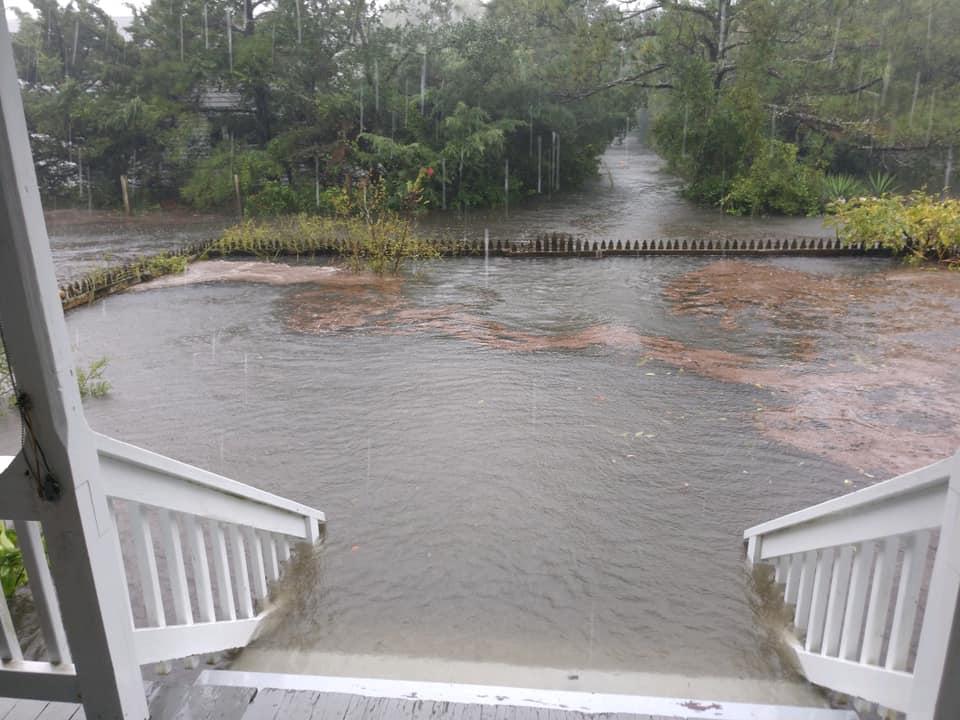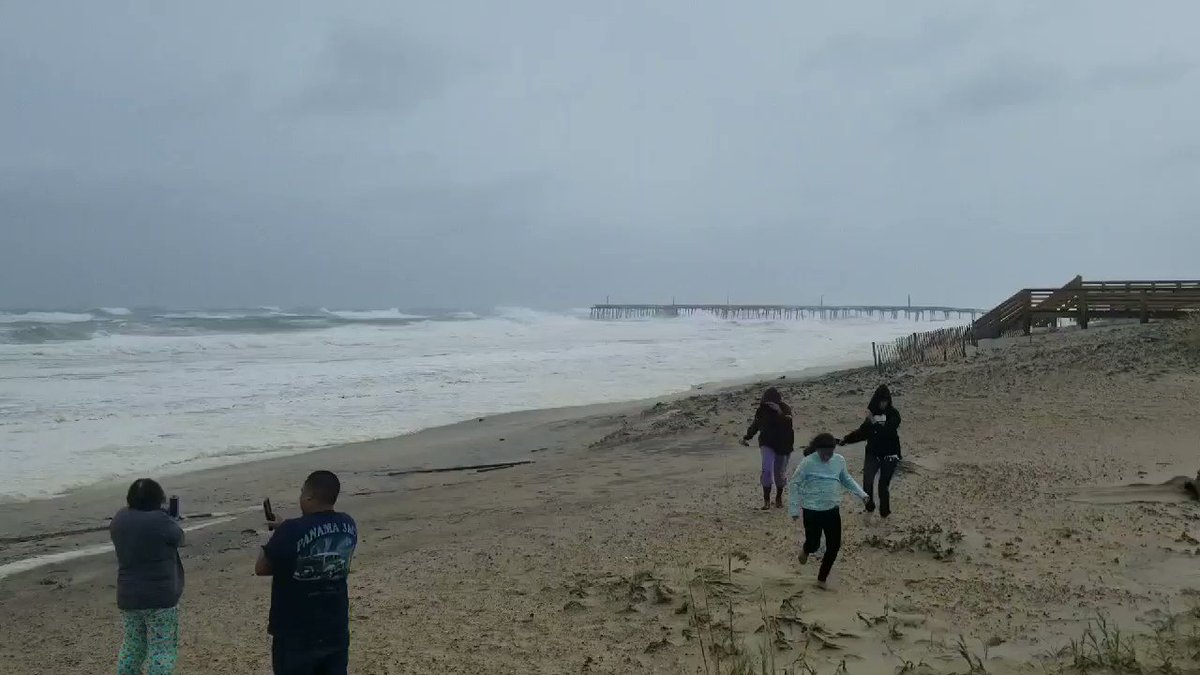By the afternoon, the storm’s core had left the Outer Banks, and while some gusty winds remained, Dorian had largely moved past the Mid-Atlantic shortly before 5 p.m., according to The Washington Post’s Capital Weather Gang. Still, forecasters warned, the storm posed a threat to areas in its wake.
“Life-threatening storm surge and dangerous winds will continue along portions of the North Carolina coast for the next several hours,” the National Hurricane Center said late Friday afternoon. The storm is also projected to scrape across eastern New England on its way north.
Storm surge flooding also began in Norfolk on Friday afternoon, and forecasters warned that water could continue to rise as high tide neared.
Videos from the Outer Banks area showed water that stretched up trees and swamped roadways. The storm drove a seven-foot surge into the Outer Banks, south of Nags Head. A gauge on idyllic Hatteras Island recorded inundation that topped five feet, more than enough to be considered major flooding.
Ocracoke Island now. Rapidly rising water due to storm surge off the Pamlico Sound. Seek higher ground immediately, Ocracoke Island, Hatteras Village, etc.
Pic credit: Amy Howard.
Dorian delivered a marathon assault on the Bahamas before slowly rumbling north, tracking a path that ran essentially parallel to the U.S. coastline while keeping its eye just offshore. Even with that, the storm rattled eastern parts of Florida, Georgia and South Carolina on its way north before crossing over the Tar Heel State.
Emergency officials urged area residents to get to the highest points in their houses. With the bridges to the islands impassable, first responders will likely need to use helicopters to transport food and supplies to hard-hit communities and to get victims of the hurricane out.
North Carolina Gov. Roy Cooper (D) said that there have been no reports of serious injuries or fatalities on the Outer Banks.
“If the collected will and prayers of the people of North Carolina could have pushed that thing off course, it would be way in the ocean by now,” Cooper told people at a feeding station at the Warner Temple AME Zion Church on the north side of Wilmington Friday afternoon.
He urged prayers for the people of Okracoke, “where the storm is continuing to rage. There are hundreds of people trapped on that island now, flooding from storm surge has occurred there.”
Rescuers are ready to go in by air as soon as the weather breaks, he said.
“We know these storms now, unfortunately, are a new normal for us,” he said. Referring to hurricanes Florence and Matthew, he said: “We’ve had three hurricanes in the state of North Carolina in less than three years.”
Cooper said although he issued a mandatory evacuation order, he leaves it up to local officials to enforce it.
“We expect mandatory evacuation orders to be obeyed, sometimes they are not,” he said. “People on the Outer Banks are often a hardy bunch. It’s not unusual for some people on the barrier islands not to leave. That’s something for local officials to decide.”
State transportation officials said there were 67 roads left impassable by high water and downed trees as of Friday afternoon — compared with the 750 road closures reported at the same time during Hurricane Florence last year.
Communities in the southeastern part of the state, many of which are still recovering from severe flooding during that storm, breathed a sigh of relief, even as Dorian’s onslaught continued.
More than 200,000 North Carolina residents were without power Friday morning, and some 4,500 people had sought refuge from the storm in shelters. Cooper urged those who had evacuated to hold off rushing back to their homes; downed power lines and potential flash floods remain deadly threats.
Authorities said that on Ocracoke Island, historic water levels were reported. Emergency personnel outside the island could not immediately reach Ocracoke, where the water was five to six feet above ground, Hyde County spokesman Donnie Shumate said Friday morning.
Transportation officials said that with all of Ocracoke Island experiencing severe flooding, they had closed North Carolina Highway 12, which runs through the Outer Banks. Power outages were also reported to affect all of Hatteras and Ocracoke islands.
On Ocracoke, hundreds of people who remained on the island are trying to get to higher ground after a sudden, massive storm surge roared through the tiny village.
“We have an absolute major disaster,” Peter Vankevich, who runs the Ocracoke Observer, the island’s main news source. “It’s unbelievable. I cannot overemphasize the impact here. I hear up in Hatteras things are actually worse.”
Vankevich said waters from Pamlico Sound came rushing into the village of roughly 600 year-round residents around 7:30 a.m. Friday.
“This storm surge came in amazingly quick,” he said.
Vankevich said people throughout the village are reporting similar conditions. He expects almost everyone on the island has lost their cars and said that several homes, including his, were damaged by falling trees.
Amanda Faulkner, a spokeswoman for the Coast Guard in the North Carolina area, said it sent three helicopters to the island around 10 a.m. Friday to search for residents in danger.
They flew one man reporting chest pains to Carolina East Hospital in New Bern, N.C. They did not plan additional flights because no one else appeared to be in distress.
Six helicopters from local, state and federal agencies were available throughout the day. It is the only inhabited Outer Banks island accessible only by boat or plane, making it particularly challenging to evacuate and reach during storms.
“When an evacuation takes place, the ferries take everyone out who wants to leave until the winds get too bad,” Shumate said. “After that, we have to wait until the Coast Guard clears the channel path.”
Officials estimated that 800 people were still on the island after Dorian struck, and they were prioritizing evacuating the elderly, people with medical conditions or anyone who needed urgent attention. They planned to take them to an inland shelter. Ferries to carry the rest back inland and bring in emergency supplies were expected to head to the island Saturday if winds slow down.
Dorian left the worst damage in Ocracoke of any hurricane in recent history.
“I’ve heard a couple of old timers saying they can’t remember it being so bad. It happened very quickly,” Shumate said. “There’s still waist-deep water to wade through. They had sustained 90 miles per hour wind on top of the flooding.”
Sam Walker, news director at Beach 104 and OBX Today, said Friday afternoon that waters from Dorian’s powerful storm surge were receding quickly, but added that winds are still strong.
Damage reports were also coming in from throughout the island. Walker said two piers lost large sections in Avalon and Nags Head, where about 75 feet from the end of pier was torn off.
“It was fine four hours ago, but the middle of Avalon pier got washed out, and the debris may have knocked out the section at Nags Head,” he said. “The debris field is all up and down the beach.”
Some other areas felt they had been spared the worst of Dorian’s wrath.
Myrtle Beach, S.C., began preparing for Dorian when officials saw the early forecasts: hurricane-force winds, massive storm surge, rain that would surely flood the streets. That was Saturday. By Thursday, though, the powerful cyclone had stayed about 50 miles off the South Carolina coast, sparing Myrtle Beach from its worst impacts.
“Well, it’s mother nature,” Myrtle Beach Mayor Brenda Bethune said Friday. “So even the best forecasts may not be what we actually see. We were very, very blessed not to get what was forecasted.”
At least two tornadoes touched down in the area, and strong winds felled trees across the city, leaving thousands without power. But by Friday morning, the sun was shining, and city trucks were clearing debris from the roads.
“We are in the cleanup efforts now, and fortunately there is not much to clean up,” Bethune said. “We look at that as a gift.”
In eastern North Carolina’s Onslow County, Emergency Services Director Norman Bryson said Friday morning that the Dorian left “minimal damage” and that officials received far fewer emergency calls overnight than on a normal weeknight.
A swiftwater rescue team that mobilized overnight to save people from dangerous floodwaters during Hurricane Florence stayed put as hurricane force winds struck the county early Friday morning.
When they drove around in trucks to survey flood-prone areas, all they found were a few knocked-over trees, some standing water in grass, and a bent mailbox. One sedan was submerged in the shoulder of a road with foot-deep water, but the occupants apparently escaped unscathed.
“This is light compared to some of the damage I’ve seen, this ain’t nothing,” said Thomas Goff of Onslow Fire and Rescue. “I’ve seen pop-up thunderstorms do more damage.”
Other areas that had watched Dorian’s path felt similarly spared. In southeast North Carolina, where Dorian passed overnight, minimal damage was initially reported. A spokeswoman for New Hanover County, which includes Wilmington, called the area relatively lucky, just with trees down and minor flooding, although crews are just going out to fully assess the area.
Some rushed back when the storm had passed, and roadways reopened. As soon as the bridge to Carolina Beach and Kure Beach opened at 9 a.m., motorists flooded across the river to get to their homes, businesses and the ocean.
Richard Lang, 68, of Kure Beach came to the ocean to check out the waves after getting his morning coffee. Once a surfer himself, he said he quit “once I got old and decrepit.”
“We get 100-year storms about every other year now,” he observed. “I could just about predict what would happen with this one. When they start bouncing off Florida, we get them every time. That big hook of Cape Fear sticks out right there and catches them.”
Kaplan and Berman reported from Washington. Jason Samenow in Washington; Patricia Sullivan in Wilmington, N.C.; Kirk Ross in New Bern, N.C.; and Reis Thebault in Myrtle Beach, S.C., contributed to this report.







